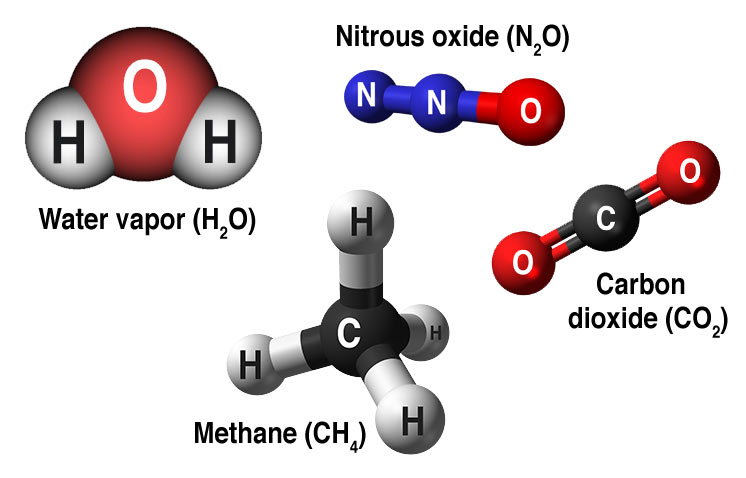Global warming occurs when carbon dioxide (CO2) and other air pollutants and greenhouse gases collect in the atmosphere and absorb sunlight and solar radiation that have bounced off the earth’s surface. Normally, this radiation would escape into space—but these pollutants, which can last for years to centuries in the atmosphere, trap the heat and cause the planet to get hotter. That's what's known as the greenhouse effect.
Gases that contribute to the greenhouse effect include:
 |
- Water vapor. The most abundant greenhouse gas, but importantly, it acts as a feedback to the climate. Water vapor increases as the Earth's atmosphere warms, but so does the possibility of clouds and precipitation, making these some of the most important feedback mechanisms to the greenhouse effect.
- Carbon dioxide (CO2). A minor but very important component of the atmosphere, carbon dioxide is released through natural processes such as respiration and volcano eruptions and through human activities such as deforestation, land use changes, and burning fossil fuels. Humans have increased atmospheric CO2 concentration by more than a third since the Industrial Revolution began. This is the most important long-lived "forcing" of climate change.
- Methane. A hydrocarbon gas produced both through natural sources and human activities, including the decomposition of wastes in landfills, agriculture, and especially rice cultivation, as well as ruminant digestion and manure management associated with domestic livestock. On a molecule-for-molecule basis, methane is a far more active greenhouse gas than carbon dioxide, but also one which is much less abundant in the atmosphere.
- Nitrous oxide. A powerful greenhouse gas produced by soil cultivation practices, especially the use of commercial and organic fertilizers, fossil fuel combustion, nitric acid production, and biomass burning.
- Chlorofluorocarbons (CFCs). Synthetic compounds entirely of industrial origin used in a number of applications, but now largely regulated in production and release to the atmosphere by international agreement for their ability to contribute to destruction of the ozone layer. They are also greenhouse gases.
Global warming is caused by human activities such as burning fossil fuels, and farming.
Burning fossil fuels
When we burn fossil fuels like coal, and gas to create electricity or power our cars, we release CO2 pollution into the atmosphere.
Australians are big producers of CO2 pollution compared to the rest of the world. Our level of CO2 pollution per person is nearly double the average of other developed nations and more than four times the world average.
Electricity generation is the main cause of carbon pollution in Australia as 73% of our electricity comes from burning coal and 13% from burning gas. The remaining 14% comes from renewable energy sources such as hydro, solar and wind, which do not emit carbon.
Reducing the amount of electricity generated from coal and gas, and increasing the amount of electricity from clean, renewable energy sources like solar and wind, means less carbon pollution is emitted. This is one of the main ways we can address global warming.
Australians are big producers of CO2 pollution compared to the rest of the world. Our level of CO2 pollution per person is nearly double the average of other developed nations and more than four times the world average.
Electricity generation is the main cause of carbon pollution in Australia as 73% of our electricity comes from burning coal and 13% from burning gas. The remaining 14% comes from renewable energy sources such as hydro, solar and wind, which do not emit carbon.
Reducing the amount of electricity generated from coal and gas, and increasing the amount of electricity from clean, renewable energy sources like solar and wind, means less carbon pollution is emitted. This is one of the main ways we can address global warming.

A large coal power station in the UK with barbed wire in the foreground © Global Warming Images / WWF
Deforestation
Plants play an important role in regulating the climate because they absorb carbon dioxide from the air and release oxygen back into it. Forests and bushland act as carbon sinks and are a valuable means of keeping global warming to 1.5°C.
But humans clear vast areas of vegetation around the world for farming, urban and infrastructure development or to sell tree products such as timber and palm oil. When vegetation is removed or burnt, the stored carbon is released back into the atmosphere as CO2, contributing to global warming. Up to one-fifth of global greenhouse gas pollution comes from deforestation and forest degradation.
Preventing deforestation as well as planting trees, through reforestation and afforestation, are important actions in the fight against global warming.
But humans clear vast areas of vegetation around the world for farming, urban and infrastructure development or to sell tree products such as timber and palm oil. When vegetation is removed or burnt, the stored carbon is released back into the atmosphere as CO2, contributing to global warming. Up to one-fifth of global greenhouse gas pollution comes from deforestation and forest degradation.
Preventing deforestation as well as planting trees, through reforestation and afforestation, are important actions in the fight against global warming.

A huge swap is burnt in Indonesia © WWF-Indonesia / Komar
Farming
Animals, livestock like sheep and cattle, produce methane, a greenhouse gas. When livestock grazed at a large scale, as in Australia, the amount of methane produced is a big contributor to global warming.
Some that farmers use also release nitrous oxide, which is another greenhouse gas.
Australian farming contributes 16% of our total greenhouse gas emissions. Using different and different stock feeds can help to reduce farming's contribution to climate change.
Some that farmers use also release nitrous oxide, which is another greenhouse gas.
Australian farming contributes 16% of our total greenhouse gas emissions. Using different and different stock feeds can help to reduce farming's contribution to climate change.


No comments:
Post a Comment